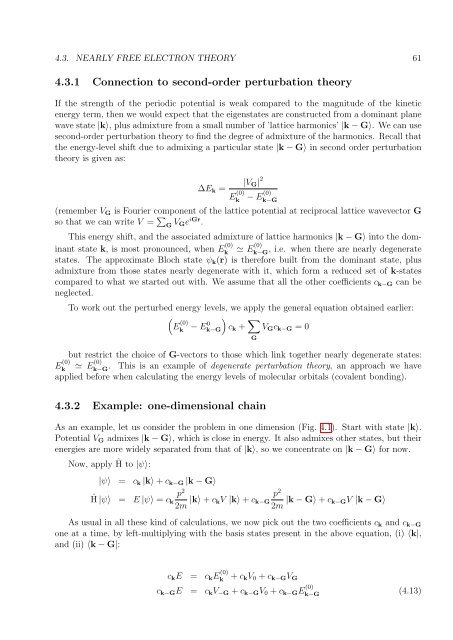Set of supplementary notes.
Set of supplementary notes.
Set of supplementary notes.
You also want an ePaper? Increase the reach of your titles
YUMPU automatically turns print PDFs into web optimized ePapers that Google loves.
4.3. NEARLY FREE ELECTRON THEORY 61<br />
4.3.1 Connection to second-order perturbation theory<br />
If the strength <strong>of</strong> the periodic potential is weak compared to the magnitude <strong>of</strong> the kinetic<br />
energy term, then we would expect that the eigenstates are constructed from a dominant plane<br />
wave state |k〉, plus admixture from a small number <strong>of</strong> ’lattice harmonics’ |k − G〉. We can use<br />
second-order perturbation theory to find the degree <strong>of</strong> admixture <strong>of</strong> the harmonics. Recall that<br />
the energy-level shift due to admixing a particular state |k − G〉 in second order perturbation<br />
theory is given as:<br />
∆E k =<br />
E (0)<br />
k<br />
|V G | 2<br />
− E(0) k−G<br />
(remember V G is Fourier component <strong>of</strong> the lattice potential at reciprocal lattice wavevector G<br />
so that we can write V = ∑ G V Ge iGr .<br />
This energy shift, and the associated admixture <strong>of</strong> lattice harmonics |k − G〉 into the dominant<br />
state k, is most pronounced, when E (0)<br />
k<br />
≃ E (0)<br />
k−G<br />
, i.e. when there are nearly degenerate<br />
states. The approximate Bloch state ψ k (r) is therefore built from the dominant state, plus<br />
admixture from those states nearly degenerate with it, which form a reduced set <strong>of</strong> k-states<br />
compared to what we started out with. We assume that all the other coefficients c k−G can be<br />
neglected.<br />
To work out the perturbed energy levels, we apply the general equation obtained earlier:<br />
(<br />
)<br />
E (0)<br />
k<br />
− E0 k−G c k + ∑ V G c k−G = 0<br />
G<br />
but restrict the choice <strong>of</strong> G-vectors to those which link together nearly degenerate states:<br />
E (0)<br />
k<br />
≃ E (0)<br />
k−G . This is an example <strong>of</strong> degenerate perturbation theory, an approach we have<br />
applied before when calculating the energy levels <strong>of</strong> molecular orbitals (covalent bonding).<br />
4.3.2 Example: one-dimensional chain<br />
As an example, let us consider the problem in one dimension (Fig. 4.1). Start with state |k〉.<br />
Potential V G admixes |k − G〉, which is close in energy. It also admixes other states, but their<br />
energies are more widely separated from that <strong>of</strong> |k〉, so we concentrate on |k − G〉 for now.<br />
Now, apply Ĥ to |ψ〉:<br />
|ψ〉 = c k |k〉 + c k−G |k − G〉<br />
Ĥ |ψ〉 =<br />
p 2<br />
E |ψ〉 = c k<br />
2m |k〉 + c p 2<br />
kV |k〉 + c k−G<br />
2m |k − G〉 + c k−GV |k − G〉<br />
As usual in all these kind <strong>of</strong> calculations, we now pick out the two coefficients c k and c k−G<br />
one at a time, by left-multiplying with the basis states present in the above equation, (i) 〈k|,<br />
and (ii) 〈k − G|:<br />
c k E = c k E (0)<br />
k<br />
+ c kV 0 + c k−G V G<br />
c k−G E = c k V −G + c k−G V 0 + c k−G E (0)<br />
k−G<br />
(4.13)








